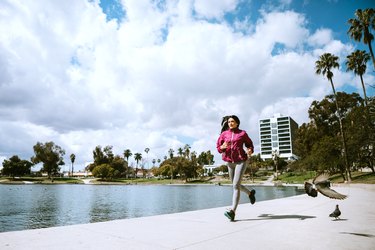
Many women strive for toned calf muscles. While some find it difficult for their calf muscles to grow and become toned, others complain their calf muscles are too large, and they search for ways to reduce the muscle bulk.
Huge calf muscles may be the result of genetics, poor nutrition or a lack of exercise. By taking the appropriate steps, you can reduce the size of bulky calf muscles without losing their toned appearance.
Video of the Day
Video of the Day
Change Your Habits
Change your lifestyle habits to reduce the size of your calf muscles. Women with muscular calves should avoid walking in high heels or in unsupported shoes, which can strengthen your calf muscles and encourage hypertrophy, or muscle growth. Do not stand for long periods of time, which can reduce blood circulation in your legs and cause swelling.
Tip
If you're in the habit of hiking or walking and running on uneven surfaces, this can also help you build stronger — and sometimes bigger — calves. If you like these activities more than you worry about "big" calves, consider reframing your thoughts to an appreciation of what your calves can do for you.
Cardio Is Key
If your calves are bigger than you like because of excess body fat, doing cardio exercises can help you to burn enough calories to reduce that excess fat. However, be warned that powerful jumping exercises are more likely to promote calf growth, so aim for lower-impact workouts that don't require as much powerful activation of your calf muscles.
Tip
Keep in mind that spot reduction, or the idea you can lose fat from just one part of your body, is a myth. To slim extra fat off your calves, you'll need to tweak both diet and exercise so that you burn more calories than you take in. Then the excess body fat will come off everywhere — including your calves.
Read more: Exercises to Slim the Calves
Stretch It Out
Stretch your calf muscles frequently, especially after exercising:
- Stand about a foot away from a wall or step. You should be facing the wall.
- Lift one leg and place it next to the wall so your toes are about 5 to 8 inches up the wall with the ball of your foot flat against the wall. Your heel should still be on the floor.
- Lean forward until you feel a pull in the back of your leg. Hold the position, making sure the leg you're stretching is straight, for at least 15 to 30 seconds before switching legs.
There are actually two primary muscles in your calves. The described stretch targets your gastrocnemius, or the largest calf muscle that is readily apparent. The other muscle is your soleus, which is smaller and essentially hidden deep to the gastrocnemius muscle.
Although you can't see the soleus on most people, stretching it can still feel good. A soleus stretch works exactly like the gastrocnemius stretch, but, instead of keeping the leg you're stretching straight, give it a slight bend at the knee to shift the focus from gastrocnemius to soleus.
Read more: The 8 Best Stretches for Your Legs
Self-Care for Your Calves
Massage your calf muscles after exercising or stretching to aid with recovery and encourage flexibility, which makes your muscles appear leaner. Knead the muscles with your thumbs, knuckles or fingers. You can also use a foam roller or other massage tools for self-myofascial release. This is another recognized technique that will help loosen many of your leg muscles, including your calf muscles.
Toning Without Bulking Up
High-intensity exercises and high weight loads contribute to hypertrophy, or muscle growth. This means that if you're doing calf exercises with heavy weight, shift back to a lighter weight instead, increasing the number of repetitions to 15 or even 20 so it's still a challenge.
That said, if you really don't like the size of your calves, you might want to skip any strength-training exercises that specifically target them, such as standing calf raises.